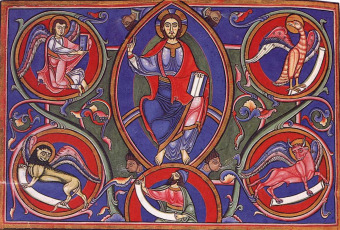There are only two Old Testament scriptures that directly reference this strange heavenly vision of a "wheel within a wheel" observed by the prophet Ezekiel.
The appearance of the wheels and their workmanship was the color of beryl, and the four of them had the same likeness. And their appearance and their workmanship was like a wheel inside of a wheel . . .
And I looked, and behold, the four wheels were beside the cherubim . . . And their appearance was as one, the four of them . . . (Ezekiel 1:16, 10:9 - 10, HBFV).
Of the many fascinating Biblical descriptions of heavenly things in the prophet's visions, delineated in chapters 1 and 10, is by far the most stunning and complex. The description itself is hard enough for us to understand since there is nothing similar to it in the Bible. We are also not told what to compare these descriptions in the prophet's visions to so that we may understand them.
Ezekiel had to describe his incredible and foreign to his experience visions using the Hebrew language.

Difficulties of Interpretation
The difficulty of understanding his writings (or any others) is that the translation of the texts from Hebrew to English is sometimes not easy nor perfect. Since there is no certain and crystal clear understanding of this subject simply by reading the text, even after consulting several Bible commentaries we can only come to an imperfect, general understanding. The Apostle Paul stated that there are many things that, as humans, we can only partly understand (1Corinthians 13:12).
Some commentaries do try to describe Ezekiel's fantastic wheel vision. The Abingdon Bible Commentary states the following.
"The description is full of the splendor of flashing light, so brilliant that the details are minutely revealed, but so dazzling that they are not clearly seen . . . Textual corruption, which do not seriously affect the general interpretation, have aggravated the obscurity in some points of detail."
Spiritually Engineered
Next to each Cherub, one wheel was place next to another one. A few Bible commentaries state that they traversed each other (one inside another). Like in a cross, they allowed the spirits to immediately go in any of four directions where they were told to go (Ezekiel 10:16 - 17).
"The two wheels for each cherub were unusual in shape; one wheel intersected another wheel at right angles. Thus they could roll in four directions without being turned and could move with the cherubim" (The Bible Knowledge Commentary on Ezekiel 1:15 - 18).
Concerning how each wheel was engineered, our limited understanding makes it quite difficult to comprehend how such things would be made in the spiritual realm.
"Those faces or sides of the four wheels moved which answered to the direction in which the cherubim desired to move; while the transverse circles in each of the four composite wheels remained suspended from the ground, so as not to impede the movements of the others" (Jamieson, Fausset and Brown Commentary, notes on Ezekiel 1:17).
"Naturally a chariot with wheels facing all four directions could not travel effectively in any direction. However, the purpose of the image is found in its symbolic value of attention to all of the corners of the world - God's omnipresence" (Bible Background Commentary).
Facets
Two more facets are also described. One facet is the "rings were full of eyes" (Ezekiel 1:18). Since eyes are for seeing, and man is made in the likeness of God (Genesis 1:26), we can safely assume that they are meant for the same. The great number of eyes on the rings may symbolize how great is God's awareness and direction of events.
"The multiplicity of eyes here in the wheels, and Ezekiel 10:12, in the cherubim themselves, symbolizes the plenitude of intelligent life, the eye being the window through which "the spirit of the living creatures" in the wheels looks forth . . ." (JFB Commentary).
The second facet was dreadful and had high rings. It is not clear whether, in regard to its shape, it means the ring depth or the large spoke size. It is important to note regarding this subject that some commentaries indulge in various allusions on the meaning of Ezekiel's wheel within a wheel that is merely speculative. We ought to be satisfied with what God allows us to comprehend regarding this vision and not add to it.